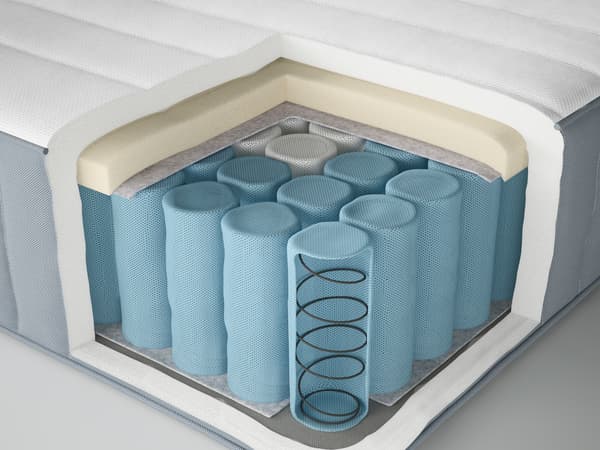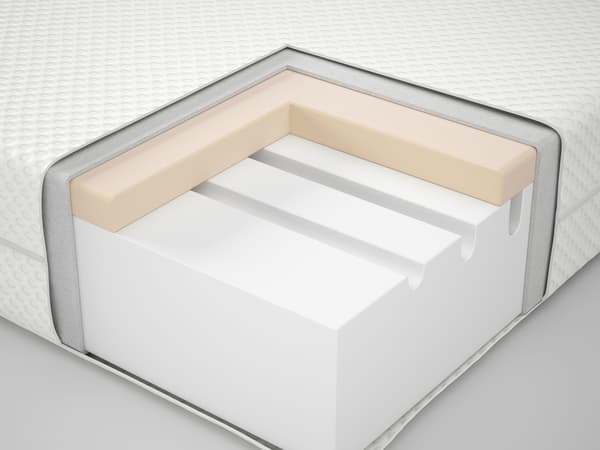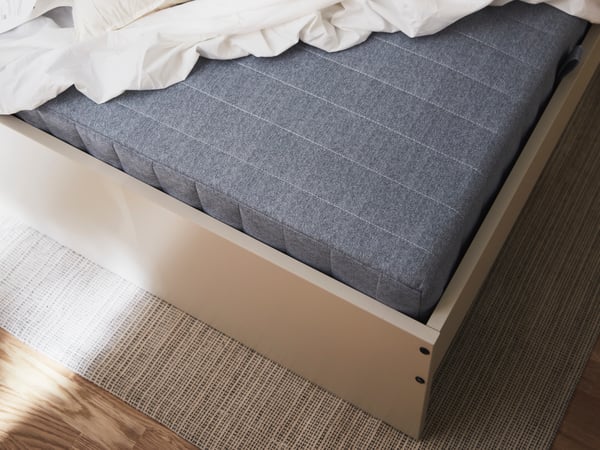How to choose a mattress that’s best for you
We offer a lot of mattresses. That’s because all bodies are different. By sharing our tips on mattress materials, firmness and size, this guide should help you get closer to your ideal mattress before trying your finalists in person. (Give them 5 minutes each with a proper pillow for your sleeping position.)


1. Decide which materials you want inside
A mattress is made from spring or foam to properly align the spine, support your body and relieve pressure. Both come in a range of sizes and firmnesses and can have comfort zones that work to prevent certain parts of your body from sinking. Nearly all are roll packed.
Spring mattresses: a bit bouncy
Spring mattresses use metal coils to distribute weight so that there’s no extra pressure on any part of your body. All have at least one layer of standard foam (or natural latex) on top for added comfort.
Typically, spring mattresses use only pocket springs or Bonnell springs. Pocket springs are wrapped in individual covers and work independently while Bonnell springs are all connected together.
- Not sleeping alone? Pocket springs are recommended over Bonnell to minimise the impact of your sleep partner’s movements.
- Too warm while sleeping? Spring mattresses allow air to circulate, which can help keep you cool.
- A wooden base spring mattress is a spring mattress inside a self-supporting frame (often pine). It’s almost a complete bed. Most have a double layer of springs.
- Hybrid mattresses include pocket springs between several layers and types of foam for sturdy, pressure-relieving support in all the right places.
Foam mattresses: a cradling cuddle
Foam mattresses use a combination of different foams to provide good support, mould to your body and relieve pressure.
Typically, foam mattresses use memory foam and standard foam (polyurethane). Memory foam is dense yet elastic and mouldable, improving blood circulation to muscles and skin, which enables you to fully relax. Standard foam creates a stable sleeping environment and can be made to feel very firm or soft. High resilience foam is a bit more durable than standard foam, and it recovers its shape fast.
- Not sleeping alone? Foam dampens and absorbs the shock of movements.
- Too cold while sleeping? Foam hugs the body and often feels warmer than a spring mattress.
2. Figure out your mattress firmness level
How to choose a mattress with the best firmness? Your sleeping position has a big role to play. Weight doesn’t define you, but it does affect support. And if you share a bed, consider two smaller mattresses with different firmness levels.

- Product information page
Medium firm mattresses are best for
- Side sleepers who weigh less than 85 kg. Why? Shapes to the shoulders and hips, especially with comfort zones. Tip: pair with a high pillow.
- Back sleepers who weigh less than 60 kg. Why? Prevents neck and lower back from sinking too deeply. Tip: pair with a low pillow.
- Stomach sleepers who weigh less than 60 kg. Why? Avoids stressing the spine. Tip: pair with a very low or no pillow.

- Product information page
Firm mattresses are best for
- Side sleepers who weigh 85 kg or more. Why? Shapes to the shoulders and hips, especially with comfort zones. Tip: pair with a high pillow.
- Back sleepers who weigh 60 kg or more. Why? Prevents neck and lower back from sinking too deeply. Tip: pair with a low pillow.
- Stomach sleepers who weigh 60 kg or more. Why? Avoids stressing the spine. Tip: pair with a very low or no pillow.
3. Size? No worries, we’ve got them all
Got your eye on a particular mattress? Make sure it fits your sleeping area, bed frame and body. Measure your space or existing frame and compare with the product measurements. Your feet shouldn’t hang off the end, and you should have plenty of room to move and turn with ease. If you share your bed, consider two single mattresses as they may meet individual needs better than one double mattress. Our mattress sizes are: single (XX cm x XX cm), double (XX cm x XX cm), etc.

- Product information page
4. Top it off with easy-care aides
No matter which mattress is best for you, a mattress protector is recommended to help it last longer, shield it from dirt and stains and maintain freshness. Other ways to care for your mattress are to vacuum it twice a year, and turn it every six months or so to even out the wear. (Spin it like a record, not flip it like a pancake.) A mattress topper can also work as a protective layer, but we recommend it with spring mattresses. A topper can counter the comfort of a foam or latex mattress.


